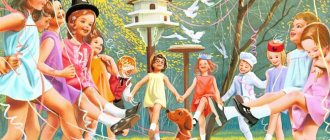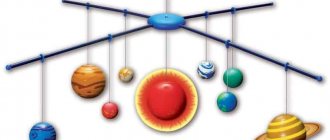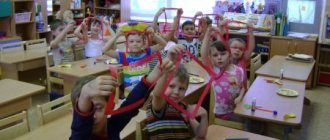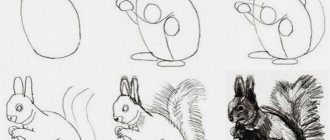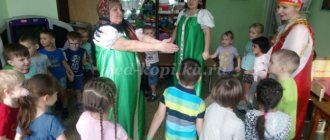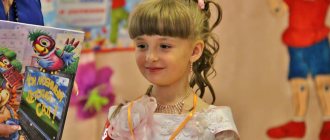Lesson summary - travel in kindergarten in the senior group on the topic: Planets of the solar system
Lesson summary for the senior group of the preschool educational institution “Space Travel”
Program content: Introduce children to the names of the planets: Earth, Mercury, Mars, Venus, Jupiter, Uranus, Neptune, Pluto; Systematize children's ideas about the Universe, the Solar system and its planets; Enrich and expand children's ideas and knowledge about space. To develop children’s cognitive and intellectual abilities, creativity and the formation of a subjective-evaluative attitude towards the surrounding reality on this topic; Learn to be attentive and inquisitive. Continue to instill in children love for the Motherland; Foster a sense of pride in one’s native country, which participated in space exploration; To cultivate a caring attitude towards what is on our planet. Materials: images of planets, a “Solar System” poster, a hoop with ribbons and numbers from 1 to 9, an Astronomer’s costume, educational games (a diagram of a rocket, parts of a spacesuit design, musical accompaniment). Preliminary work: reading educational stories from the children's encyclopedia "Cosmos", a series of conversations on the topic "The Earth is the planet on which we live", observing the sky in the evening and morning, reading fiction and documentary literature about space;
drawing, appliqué, memorizing poetry. Progress of the lesson
Children sit on chairs that stand in a semicircle in front of the “solar system” illustration. Educator: children, if you look at your feet on the street, what will we see? Children: We will see earth, asphalt, grass. Educator: And if you look up, what do you see? Children: We will see the sky, clouds, the sun, and at night the stars, the month. Educator: What is the name of the planet on which we live? Children: The planet we live on is called Earth. Educator: What is the Earth like? Children: The earth is like a ball Educator: Correct. Earth and sky are our planet with seas and oceans, rivers, lakes and land. Beyond it is space. Reading a poem.
A pilot in a space rocket looked at the sky from above, No one, no one in the world has ever seen such beauty!
Oh, what beauty it is all around! We are not afraid of heights! And we, friends, inform you that there is no more beautiful earth. Educator: Since ancient times, the mysterious world of planets and stars has attracted the attention of people, beckoning them with its mystery and beauty. In the distant past, when people first began to explore the Earth, they imagined it as an inverted bowl resting on three giant elephants standing on the shell of a huge turtle. Several thousand years have passed since then. During this time, many generations of kind and intelligent people have changed on our planet. They built ships and, traveling around the world, confirmed the knowledge that our planet Earth moves at enormous speed in outer space, making one revolution around the Sun per year. Blue ball covered with white clouds. (Show illustration). This is what the Earth looks like from space. Astronauts who have seen our planet from the outside say that it is amazingly beautiful. Educator: Do you dream of going to space? Children's answers. Educator: If you really want to go into space, you can fly away. The bravest will be our cheerful, friendly crew. (There is a knock on the door. The Astronomer comes in to the music, holding an envelope with assignments in his hands.) Astronomer: Good afternoon, children! I am an Astronomer. One day, flying over a kindergarten, I saw a group of children watching the sun, then I noticed how in the evening and morning hours you watched the stars and the moon. You are so inquisitive, and I really love smart and inquisitive children. Tell me, kids, would you like to travel around my space kingdom? Therefore, I want to invite you on an unusual space journey. Interesting adventures and various challenges await you. Do you agree? Aren't you afraid of difficulties? Distant stars are shining in the sky, They are calling smart guys to visit. It doesn't take long for us to get ready for the trip - and now we are just ready for the flight. Let's play. First, let's remember what needs to be prepared for a flight into space. Children: Since we are going to fly, we need to build. (Starship.) Educator: Correct. And we will build according to the project that our friend kindly provided us with. The astronomer offers an envelope with the first task. Children build a starship from geometric shapes. Physical education lesson In order to control a rocket, you need to become strong and dexterous. They don’t take the weak into space, because flying is not easy work! We will train, we will gain strength. Left, right, turn around, turn around yourself. (3-4 rubles) Squat, (4-5 rubles) Jump (7-8 rubles) And sit down in your seats Didactic game “Cut-out pictures” Astronomer: To fly into space you need special suits - spacesuits. I suggest you collect them. Children assemble spacesuits from pieces. Educator: And now the children are with you, we are flying away on a starship. Put on imaginary spacesuits. (Children tap their fingers on the head, shoulders, arms, torso, legs.) Go to the ship’s interior, select a space chair. It is necessary to put on the straps and fasten the seat belts. Starship, starship takes flight. Five, four, three, two one (the sound of a rocket taking off) During the launch, we will shake a little until we pass through the dense layers of the atmosphere. (Children imitate shaking) It won’t take long, soon our ship will enter a calm flight mode (the shaking stops, the song “Earth in the Porthole” sounds). Children, we have entered a calm mode.
During the flight you can move around our ship. Listen to the command “Unbuckle your seat belts.”
Look, what do you see in the porthole? Children: We see the Sun, planets, stars, comets. Educator: We live in the solar system, in a large “family” of planets. They are all different in size, natural conditions, and structure. They fly around the Sun in different ways. Some are closer to him, others are further away. Planets can be seen in the sky because they are illuminated by the Sun. Sunlight reflects off the planets, which is why the planets can be seen from Earth. They are especially visible at night, when they glow like bright stars. Earth is the third planet from the Sun. (Then children get acquainted with the names of other planets: Mercury, Mars, Venus, Jupiter, Saturn. Show illustrations). Didactic game “Arrange the planets correctly.” Each planet has its own path. Believe me, it cannot be pulled out of orbit. Our planets revolve around the Sun. They are all warmed by the Sun in different ways. The child “Sun” is selected, and a belt with sewn rays-ribbons of different lengths is put on him. There are nine of them. Nine children have hats with images of planets on their heads; they differ in size and color. There are rings on Saturn's cap. At the end of each ribbon there are numbers from 1 to 8. Mercury-child: The very tiny planet First is warmed by the Sun, And the year on it is Eighty-eight days. -What is our hottest planet? Where is it located? (Mercury, because it is closest to the sun.) The Mercury child takes up ribbon No. 1. The Earth is a child: There is beauty on the planet: Oceans and forests, Oxygen is in the atmosphere, People and animals breathe it. — In what orbit does our planet Earth rotate? Where is our planet from the sun? (In 3rd place) Child-Earth takes up ribbon No. 3. Venus - child: Only the Sun and Moon are brighter in the sky than she is. And there is no hotter planet in the solar system. — Venus, kids, was once called “sister of the Earth.” On the surface of Venus the temperature is about five hundred degrees. Child-Venus takes up tape No. 2. Mars - child: Kamenyuki Fear and Horror are circling over the red planet. There are no mountains in the world Higher than on this planet. — What place will Mars take? Child Mars takes up tape No. 4. Jupiter is a child: A heavyweight giant Throws lightning from the sky, He is striped, like a cat, It’s a pity that he is losing weight little by little The largest planet, what is it called? What orbit is it in? (Jupiter, orbit No. 5) Child-Jupiter takes up ribbon No. 5 Saturn - child: Curvy gas giant Brother of Jupiter and dandy Loves rings of ice and dust flying around. Child-Saturn occupies orbit No. 6. Uranus - child: What is the Green planet? Child-Uranus occupies orbit No. 7. Neptune - child: On the planet blue-blue The wind is blowing very strong. There is no summer there at all - Winter is very long here. Child Neptune occupies orbit No. 8. All children have taken their places and begin to revolve around the “Sun”. The round dance of the planets is spinning. Each has its own size and color. For each, the path is determined, But only on Earth is the world populated with life. It's time for the astronauts to return to Earth. Stand in a circle, hold hands. Close your eyes, turn on the energy of love for your native Earth and pass this energy on to your friends. Observe what happens inside you. (space music sounds)
Let's fly home!
Open your eyes. Here we are at home. Let's take off the spacesuit. (Children clap their hands around their bodies: left, above, right, below.) Good! Summary of the lesson. And at the end of our space lesson, let's thank our Astronomer and wish him successful flights into space and new space discoveries! (Children say goodbye to the Astronomer)
We recommend watching:
DIY board game for kindergarten on the theme: Space A project on the theme “Space” in the middle group of the kindergarten. Video presentation Summary of GCD (application) in the middle group of kindergarten on the topic: Space Entertainment for children of the preparatory group in kindergarten on the topic: Space
Similar articles:
Conversation in the preparatory group “The sun is the source of life on earth”
Conversation in the preparatory group. The Moon is the Earth's satellite
Conversation for children of the senior group “Planets of the solar system”
Stories about Gagarin for children
Summary of the lesson “Starry Sky” in the middle group
CARD INDEX OF DIDACTICAL GAMES IN ASTRONOMY for PRESCHOOL CHILDREN
How do you know which is heavier: a bag of air or water? (Children weigh them in their hands and draw conclusions: air is lighter than water).
Simulation Games
"What is the sun?"
Tasks:
develop a perspective vision of the basics of constructing objects, teach how to create a model of the Sun.
A balloon flew to us, he is very afraid of the Sun. Let's draw the Sun and tell about it.
Problem situation:
What is the Sun? (children’s reasoning and answers).
Sun —
This is a medium-sized star that is closest to Earth, it is a hot ball of gas.
Could we live without the Sun?
The teacher invites the children to build a model of the Sun. Children collectively model a star on the carpet using ropes, ribbons, threads, paper, etc. Next, each child is invited to draw his own sun to the sound of quiet music. Then the children explain to the balloon what the Sun is.
“How does the solar system work?”
Tasks:
develop the ability, with the help of an adult, to create a model of the solar system.
Let's imagine that we are astronauts and flying on a ship. We move from the Sun and fly to each planet (the teacher suggests modeling the Solar System by placing the Sun in the center (picture) and around it all the planets (plastic circles) located on trajectories (threads).
“What is the earth made of?”
Tasks:
create a model of a small area of the earth's surface.
Problem-search situation:
What is Earth? What is she like? (the teacher talks about the planet Earth, then the children independently create a model of the earth from plasticine (a ball), and then model a small section of the earth’s surface with mountains, plains, depressions using paper, pasting and painting different molds —
in a group, as well as using sand, water, stones
-
on the street. Next, the children summarize the results of their work).
Didactic games on astronomy
"A Thousand Stars"
Tasks:
to develop the ability to coordinate joint actions and develop imaginative thinking in preschoolers.
Children are divided into two groups: one —
the stars, the other
the
sky. Children of the second group form a circle, hold hands, and slowly move in a circle. Child stars are collected in a bag. The teacher releases the stars from the bag into the sky with the words “A thousand stars in the sky.” With these words, the children depicting the sky form a rotating circle. The stars scatter and they begin to flicker inside the circle-sky (children can then change roles).
"Let's be astronauts"
Tasks:
to develop the ability to listen carefully to music, change movement in accordance with its character, and develop creative imagination.
Players stand in 2-3 circles (teams). Each team receives three ribbons. To one music they depict the builders of a starship and the readiness of the rocket for flight, to the second —
take places in the rockets and imitate the flight, under the third
-
marching
-
they depict a ceremonial parade after landing. The team that incorrectly identifies the content of the music loses the ribbon. The game is repeated 4-5 times.
Space Truckers
Age: from 13 years Price: from 2990 rubles
This is a game about assembling a spaceship from a bunch of parts of sewer systems, smart houses, as well as a lot of engines, guns and cargo compartments. The faster you navigate and select the elements of the future ship, the better prepared you will be for the journey. Whoever finished assembling the ship the fastest takes off first. If you're lucky, the ship will reach the destination planet. Spoiler: almost everyone reaches the final, as a rule, with partially damaged ships, but with the received cargo and a reward for the speed of delivery.
It's up to you to give or not to give the game. Because besides games, you can choose a cool gift for Cosmonautics Day. For example, these T-shirts from Odevayka will not leave any space lover indifferent.
Fight for the galaxy
Age: from 12 years Price: from 1290 rubles
You have to create the most prosperous state in the Universe. Each round consists of five main phases: search, improvement, development, consumption and production. This is a deep board game that can be played by two. Quite complex rules and many nuances; the game reveals itself only after several games. There are complaints about the quality of the components, but not about the thoughtfulness of the plot. A very interesting game for teenagers and adults.

